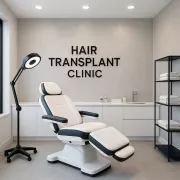
Hormonal Hair Loss at My Hair UK Clinics
Hauptsitz
35 Berkeley Square W1J 5BF London Vereinigtes Königreich
Über uns
Understanding Hormonal Hair Loss
Hair loss linked to hormones is something we see every day in clinic. It is not one condition but a set of overlapping problems that change how hair grows and sheds. The best known form is androgen driven loss, which is where the hormone dihydrotestosterone binds to sensitive follicles. Over years this causes the thick strong hairs to shrink until they become fine wisps and eventually stop growing. You might notice your hairline creeping back, or the crown becoming thinner. In men this usually follows a familiar pattern. In women it looks different, often with a widening parting rather than a receding front. Research has shown just how central this process is to male and female pattern baldness.
How Women Present
For women there is more complexity. Female pattern hair loss can happen without any other medical condition but it is often linked with hormonal shifts around the menopause or with conditions like polycystic ovary syndrome. The appearance is usually diffuse thinning on the top of the head while the front edge of the hair remains intact. Many women come to us worried about sudden shedding and a noticeable change in volume. Part of our role is to separate hormonal loss from other causes such as nutritional deficiencies or thyroid problems. Studies highlight how much this affects confidence and wellbeing, which is why proper medical assessment is essential.
The Role of the Thyroid
The thyroid is one of the most common hidden culprits. When thyroid hormone is too low or too high, the hair cycle shifts and many follicles enter the resting phase at once. This produces a generalised shedding that can feel dramatic. Treatment here is not cosmetic but medical. Replacing thyroid hormone in hypothyroidism or bringing down overactivity in hyperthyroidism gives the follicle a chance to return to normal growth. It takes time because the hair cycle is slow, so patients need to know that improvement may take months rather than weeks. NHS advice recognises hair loss as part of the symptom picture and stresses that treatment of the thyroid disorder itself is the priority.
Polycystic Ovary Syndrome
Polycystic ovary syndrome is another area where hair and hormones intersect. High androgen levels can make scalp hair thin even while hair grows more strongly in unwanted places. International guidelines now recommend a thorough approach which includes screening for metabolic problems as well as reproductive issues. For us the important point is that scalp directed treatment may not be enough unless the hormonal imbalance is also addressed with medication like Spironolactone. That means working closely with GPs and in some cases endocrinologists.
Medical Assessment at My Hair UK
At My Hair UK we start with the basics. We examine the scalp, look at the pattern, ask about family history and timing, and often suggest blood tests through your GP before you even step into surgery. A thyroid profile, ferritin levels and in some women an androgen screen can make all the difference in tailoring treatment. The reason we focus so much on androgens is that the enzyme 5 alpha reductase converts testosterone into dihydrotestosterone, the hormone that drives follicle shrinkage. Drugs that block this conversion have been shown in trials to slow or stabilise loss. Dutasteride is stronger than finasteride in some studies but both need careful discussion about side effects. Topical finasteride is emerging as an option with less systemic absorption, though it is not suitable for everyone.
When Surgery Becomes an Option
Surgery comes into the picture when the condition has been stabilised and the pattern is clear. A hair transplant does not change the hormonal cause but it can restore coverage and reshape hairlines by moving healthy follicles from the donor area at the back of the head. The key is timing. If you operate too early you risk chasing a moving target. Once things are steady we can plan a conservative restoration. In practice this might mean anything from one thousand to two and a half thousand grafts depending on your needs. Our hair transplant prices are set in clear bands: one thousand grafts is £2,899, around fifteen hundred is £3,299, two thousand is £3,699 and two and a half thousand is £4,099. These figures include the procedure and aftercare.
Why You Should See Your GP First
Before coming to us it is worth booking an appointment with your GP. Ask for a basic health check and blood tests that include thyroid function, ferritin and in women with irregular cycles or acne, an androgen screen. Bring any results with you when you attend your consultation. This saves time and ensures we do not overlook a systemic condition that needs treatment before we discuss surgery.
Planning Treatment Together
When it comes to treatment planning, we weigh up the options together. If androgen activity is the main driver we consider DHT blockers either oral or topical. If thyroid disease is the cause then medical correction is the first line and we allow the cycle to reset before making surgical plans. In every case we balance the medical and surgical so that expectations are realistic and results sustainable.
Further Reading:
https://jobs.meinbezirk.at/organization/hair-growth-cycles-and-transplants
https://jobs.meinbezirk.at/organization/my-hair-clinics
https://jobs.meinbezirk.at/organization/success-rates-hair-restoration
https://jobs.meinbezirk.at/organization/hair-restoration-leeds